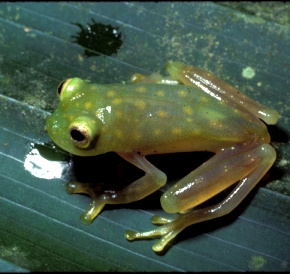Glass Frog
Fleischmann’s Glass Frog (Hyalinobatrachium fleischmanni) Spanish Name: Rana de Vidrio

More about Glass Frog
Habitat and Range
This glass frog lives near rapid streams, both in cleared areas as well as the canopy level of trees. This species can be found from Mexico through Central America to Ecuador, Colombia, Venezuela, and the Guianas.
Physical Description
Glass frogs look similar to tree frogs, except that the eyes of a glass frog are oriented forward, whereas the eyes of a tree frog are oriented to the sides. This nocturnal frog stays camouflaged during the day on the underside of leaves, often above water. It is tiny, semi-translucent, and a leaf-green color; its appearance, paired with its tendency to freeze when approached, make this amphibian hard to spot.
If the glass frog is discovered, its fragile bones and some red veins are visible through a transparent belly. The yellow hands are also translucent, and the pale green skin with pale yellow dots matches leaf perches. To better disappear, the frog’s body is flat, and its total length is usually about an inch. The fingers and toes have enlarged, adhesive disks that help with climbing. Fleischmann’s Glass Frog has large, golden eyes that stay concealed when it sleeps during the day.
Biology and Natural History
More than 100 species of glass frogs live throughout Central and South America. Adults are most active on nights with light precipitation, which helps prevent them from drying out. They have to hide during strong rains, though, because their bodies are fragile. An adult can be knocked off its perch on a leaf by heavy rain, and some have been observed dying from a single direct hit by a raindrop.
Males are not tentative though, especially not with their territories. Males call in their high peep or wheet from under their leaves; if a desired female approaches or if an undesired male intrudes, the first male begins mewing. If the invading male persists, the conflict ends in an arboreal wrestling match; once one male is pinned down, he will leave after the winner releases him.
Meanwhile, females descend to levels closer to the streams where the males call, but only on nights during the breeding season. They intentionally search for their favorite males, engage in amplexus, lay their eggs on a leaf above a stream, and return to the tree tops. Adults try to time the hatching of the clutch with rain so that the tadpoles may be washed into the stream. If they are not flushed from the leaves, the tadpoles will wiggle off and drop into the water. With rain, the streams are cloudier, and better hide the tadpoles.
Diet
The diet of this frog is not well understood, but it probably feeds on small insects.
Height/Weight
An adult male Fleischmann’s Glass Frog is generally 19-28 mm long; larger females measure 23-32 mm.
Brief Taxonomy
Order: Anura
Family: Centrolenidae
Source
Henderson, Carrol L. Field Guide to the Wildlife of Costa Rica. University of Texas Press, Austin, 2002.
Leenders, Twan. A Guide to Amphibians and Reptiles of Costa Rica. Zona Tropical, S.A, Miami, FL, 2001.
Savage, Jay M. The Amphibians and Reptiles of Costa Rica: A Herpetofauna between two Continents, between Two Seas. The University of Chicago Press, Chicago, 2002.
Amy Strieter, Wildlife Writer
Glass Frog Sightings
Similar Profiles
It's more than just having a good time or visiting beautiful places (although that's absolutely a part of it!), it's about being part of a unique experience that stays with you.



